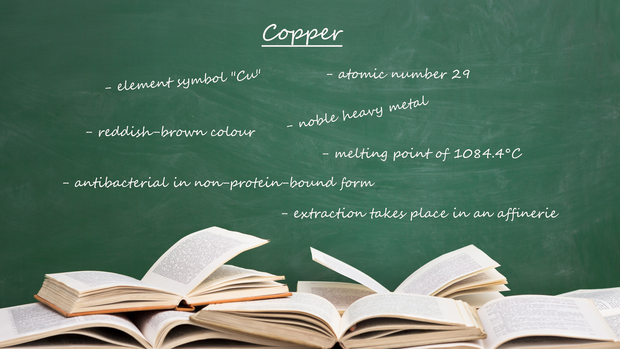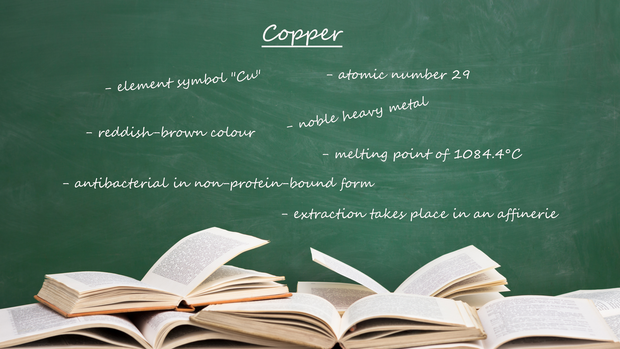Copper is a chemical element, which is marked with the element symbol "Cu" and the atomic number 29.
It has a high melting point of 1084.4°C, which is much higher than that of lead but lower than that of titanium.
Copper is a salmon pink or reddish shiny looking metal. It rarely occurs naturally in pure form and
is mainly found in basaltic lavas and copper ores such as chalcopyrite, chalcocite, bornite, atacamite and malachite.
The largest deposits of copper are in Chile, the USA, Russia, Zambia, Canada and Peru.
Properties of Copper
Copper is a noble heavy metal that conducts electricity and heat very well.
When exposed to air, copper acquires a reddish-brown colour through oxidation.
With increasing purity, copper becomes softer and softer, making it easier to process.
Copper is antibacterial in non-protein-bound form, but is generally slightly toxic.
Furthermore, copper has a high corrosion resistance, which is why it is often used in roofing sheets.
The extraction of copper takes place in an affinerie. For this purpose, chalcopyrite is first roasted with coke. The resulting iron oxides are then slagged with additives to produce iron silicate slag. This floats on copper stone and can thus be easily poured off. Now copper stone has been obtained, which is further processed into copper. To do this, the molten copper stone is poured into a converter, into which air is then blown.
In this way, the iron sulphide contained is roasted to iron oxide,
which is again bound to slag and poured off. Two thirds of the copper stone is now oxidised. This settles with the remaining sulphide to form crude copper. This raw copper is finally electrolytically cleaned,
whereby the impure copper is located at the anode and flows as ions to the cathode. The resulting electrolytic copper has a copper content of 99.99%. Copper can be used in many ways, for example in coins,
power cables, jewellery or cutlery.
By way of example, "brass" is an alloy that consists of a copper-zinc alloy. This copper alloy has a zinc content of between 5% and 45% and with increasing zinc content the alloy turns more yellow and becomes harder. This makes for better machining (milling, turning, drilling or grinding).
This alloy, "brass", is also used in many products such as pipes or fittings that require high corrosion resistance or stability. Another alloy with copper is "bronze". This is a copper-tin alloy in which the tin content can be between 8% and 20%. Here, an alloy with up to 8.5% tin is called a wrought alloy. A tin content between 9% and 12% is called a "cast alloy" and a tin content of 20% is a "bell alloy". Bronze is used, for example, to make pipes, stressed gears or screws. However, copper is present in a variety of other alloys, including in combination with nickel or aluminium.
Do you wish to have a component made of copper or copper alloy with the help of contract manufacturing?
Make an enquiry. All you have to do is upload your drawing to PART FACTORY, specify a quantity
and we will get back to you with an offer in line with the market.
Try it out and make an enquiry today.



